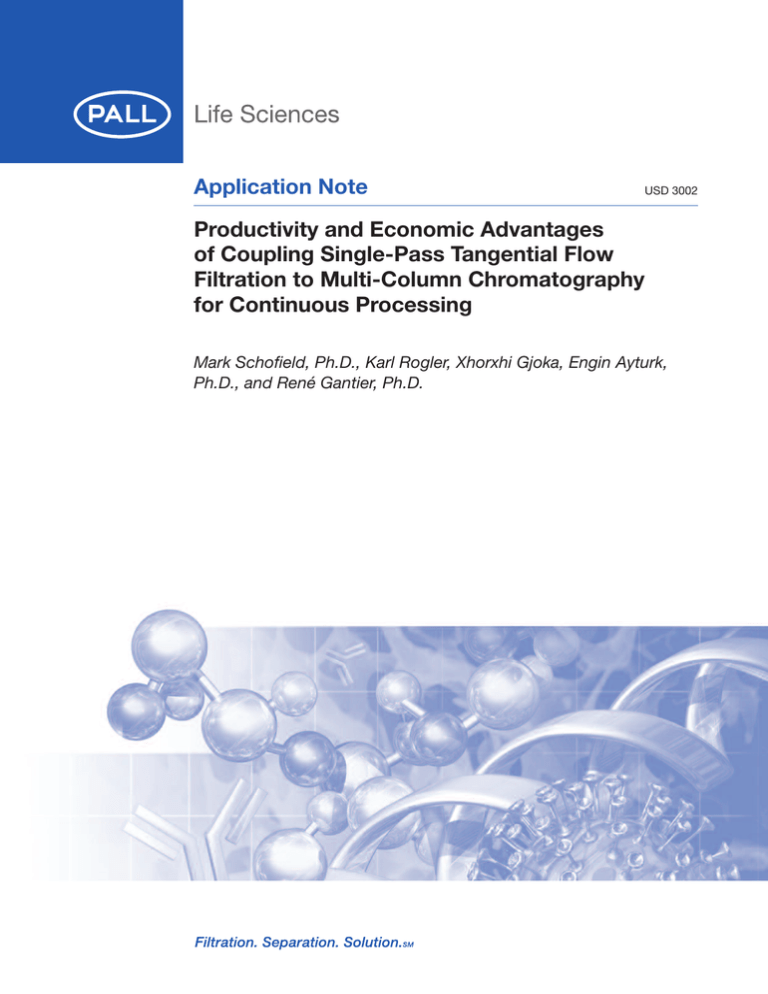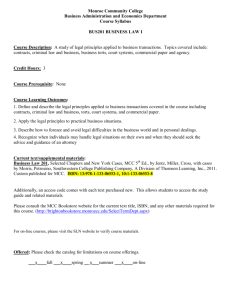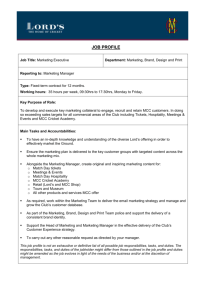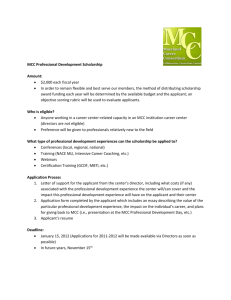Application Note Productivity and Economic Advantages of Coupling Single-Pass Tangential Flow
advertisement

Application Note USD 3002 Productivity and Economic Advantages of Coupling Single-Pass Tangential Flow Filtration to Multi-Column Chromatography for Continuous Processing Mark Schofield, Ph.D., Karl Rogler, Xhorxhi Gjoka, Engin Ayturk, Ph.D., and René Gantier, Ph.D. Table of Contents Summary .........................................................................................................................................................3 1. Introduction ..................................................................................................................................................3 2. SPTFF-MCC Process Feasibility.................................................................................................................3 2.1 Process Setup ........................................................................................................................................3 2.2 Performance of SPTFF-MCC Run Compared to Batch and MCC Processes ..........................................5 3. SPTFF-MCC Process Stability ....................................................................................................................6 4. Process Economics Analysis ......................................................................................................................6 5. Conclusions..................................................................................................................................................7 6. References ...................................................................................................................................................8 2 Summary Single-pass tangential flow filtration (SPTFF) followed by multi-column chromatography (MCC) was used to continuously process a cell culture supernatant containing a monoclonal antibody (MAb) via Protein A affinity chromatography. This study demonstrates the benefit of such a combination in term of process robustness, productivity and economics of continuous processing. The SPTFF technique can readily be implemented for continuous processing via automated skids, and the flexibility of the technique allows for better control of the purification steps by normalizing the protein concentration from cell culture to chromatography. Moreover, while continuous multi-column operation results in high productivity at high protein titer, combining SPTFF and MCC when a low protein titer is used maintains this process productivity and economical gain compared to conventional batch chromatography. Perfusion cell culture, seen as the method of choice for continuous upstream processing, currently provides such limited protein titers. The use of SPTFF after perfusion and before MCC enables significant process cost reduction without a requirement for cell culture improvement to transfer bio-processes from batch to continuous mode and increase speed to market. 1. Introduction There is a rapidly growing interest in continuous bio-processing within the biopharm industry, which is driven by the potential reduction in operational, capital and consumable expenses compared to batch processing. On the upstream side of the process, some companies are already implementing perfusion cell culture to allow for truly continuous protein expression[1], however this technique provides limited product titers (e.g. up to 1g/L for production of MAb). On the downstream side of the process, the development of MCC derived from the simulated moving bed technique enables highly productive continuous downstream processing, leading to significant process cost reduction. Up to 5 fold increased productivity can easily be achieved using continuous multi-column chromatography compared to conventional batch chromatography[2], but such an increase is limited to processes using high protein titers (> 1 g/L). When using lower protein titers, such as those achieved by continuous perfusion cell culture, the gain in productivity is lower. This application note describes the combined use of SPTFF[3-6] and MCC for continuous MAb capture from CHO cell culture via Protein A affinity sorbent. Clarified feedstocks containing low MAb concentration (≤ 1 g/L) were used to mimic a typical product titer achieved from perfusion cell culture. A first process was conducted for a few chromatography cycles only to demonstrate the feasibility of such a combined process. The performance achieved with the SPTFF-MCC process was compared to equivalent batch and MCC processes in term of specific productivity, calculated as the mass of MAb produced per liter of resin per hour. A second SPTFF-MCC process was performed for 24 hours to illustrate the stability of the configuration. Product purity and process productivity were monitored to understand the process stability. Finally, a process economic study was conducted to measure how the increased process productivity can be translated into economic benefits. 2. SPTFF-MCC Process Feasibility 2.1 Process Setup The initial SPTFF-MCC process comprised of three chromatography cycles (each column loaded three times). The process was performed using a low titer feedstock with the setup shown in Figure 1C. www.pall.com/biopharm 3 Figure 1 Process Setup for SPTFF-MCC Process (C) Compared to Conventional Batch (A) and MCC (B) Processes A Load Wash / Elution / CIP / Re-equilibration B C O L U M N C O L U M N Load C O L U M N C SPTFF Load WASTE SURGE TANK (Optional) C O L U M N C O L U M N Wash / Elution CIP / Re-equil. C O L U M N C O L U M N C O L U M N The process steps (washes, elution, clean-in-place and re-equilibration) are the same steps employed by comparable batch and MCC processes (Table 1). Table 1 Process Steps Used for the MAb Capture on Protein A Sorbent Step Buffer Volume (CV) Load Wash 1 Wash 2 Wash 3 Elute CIP Equilibration Feedstock PBS PBS + 0.5 M NaCl PBS 50 mM acetic acid, pH 3.5 0.1 M NaOH PBS Up to OBC* 3 2 3 10 10 10 *Operating Binding Capacity The volumetric concentration factor (VCF) was fixed to 5.5 for the SPTFF to obtain a MAb loading concentration on to MCC of 2.2 g/L. Operating binding capacity and residence time for batch, MCC and SPTFF-MCC processes (Table 2) were defined from breakthrough curve experiments performed using the same feedstock at 0.4 and 2.2 g/L MAb with a series of different residence times. 4 The MCC process only requires 3 columns to keep the load continuous while 4 columns are engaged for the SPTFF-MCC process to accommodate a balanced cycle with the higher load concentration. A typical continuous chromatography process is used for MCC and SPTFFMCC. At any point in the chromatography cycle, one column is in the load zone and another column receives the flow through from the load column. This enables the more complete utilization of the load column while avoiding any loss of product in the flow through. The other columns are performing the remainder of the chromatography process steps: wash, elute, CIP and re-equilibration. When the operating binding capacity is achieved on the load column, this column switches to the rest of the process steps, the column previously receiving the flow through is now receiving the load, and a previously equilibrated column is connected in series to capture the product breaking through. 2.2 Performance of SPTFF-MCC Run Compared to Batch and MCC Processes The performance of the SPTFF-MCC run compared to batch and MCC processes is summarized in Table 2. Table 2 Performance of SPTFF-MCC Process Compared to Batch and MCC Processes Process Number of OBC* Residence Columns (mg/mL) Time (min) Batch 1 MCC 3 SPTFF-MCC 4 26 39 39 5 1 1 Initial MAb titer (mg/mL) SPTFF VCF (fold) Post SPTFF Cycle MAb conc. Time (mg/mL) (min) Specific Productivity (g/L/hr) 0.4 0.4 0.4 N/A N/A 5.5 0.4 0.4 2.2 3.0 8.0 30.8 515 293 76 *Operating Binding Capacity For the batch process, a 5-minute residence time is employed to operate at a dynamic binding capacity of 26 mg of MAb per mL of Protein A resin. Thus, the load time required to reach the operating capacity using this feedstock (0.4 g/L) is ~5.5 hours, and the total cycle time 8.6 hours. The resultant specific productivity is 3 g/L/hr for the batch process. For the MCC process, the residence time can be reduced to 1 minute, yet higher operating binding capacity is achieved (close to 40 g/L) thanks to better column utilization in multi-column mode compared to batch. Even though the residence time is short, since the MAb concentration going to the column is low (0.4 g/L) and the binding capacity high, a long load time is still required to reach the operating binding capacity (~1.6 hours). This makes the total cycle time almost 5 hours, and the specific productivity for this process relatively modest (8 g/L/hr). This is only 2.6 fold improvement over the equivalent batch process. The SPTFF-MCC process employs the same residence time and operating capacity as MCC, but the load time is significantly reduced (to ~20 minutes) due to the higher MAb load concentration (2.2 g/L). The total cycle time is therefore greatly reduced (to 76 minutes) and the subsequent specific productivity is boosted to almost 31 g/L/hr. This makes the specific productivity 10-fold higher than that of the batch process and almost 4-fold higher than that of the MCC process. The MAb elution quality from these three processes – batch, MCC and SPTFF-MCC – is roughly equivalent. No significant differences were seen in MAb aggregates or host cell proteins (HCP) contamination, data not shown. The results from this SPTFF-MCC run clearly demonstrate the feasibility of such a process. An order of magnitude increase in productivity can be achieved by employing SPTFF-MCC vs. batch processing, and this improved performance does not come at the expense of product quality. www.pall.com/biopharm 5 3. SPTFF-MCC Process Stability The second case study was undertaken to demonstrate the stability of the SPTFF throughout the duration of a long process, > 20 hours. The process was configured the same as the first case study, employing 4 columns in a balanced cycle. However, a new feedstock was employed, that had a 1 g/L MAb titer. As all the parameters are the same except for the starting titer, the optimum loading concentration is still 2.2 g/L. However, as the initial titer is higher (1 g/L vs 0.4 g/L), a lower VCF of 2.2x is required. The performance data for the process can be seen in Figure 2. By the third cycle, the process analytics, including MAb aggregates, HCP content in elution fractions from Protein A, and process productivity can all seem to be reasonably stable. Figure 2 SPTFF-MCC Process Stability Monitored for 20 Hours. A: HCP and Aggregate Content in Elution Fractions From Protein A. B: Calculated Process Productivity A 600 3 400 2 200 1 0 0 0 200 400 600 800 1000 1200 Time (min) B 30 4 Productivity (g/L/hr) Elute HCP % Aggregate % Aggregate Elution HCP (ppm) 35 5 800 25 20 15 10 5 0 0 200 400 600 800 1000 1200 Time (min) Both the feasibility and the long process runs demonstrate the ability of SPTFF to maximize the productivity of MCC by supplying an optimized load concentration to the chromatography process. The SPTFF-MCC process is stable and does not impact the product quality. 4. Process Economics Analysis To highlight the financial benefit and not just the productivity benefit of including SPTFF before MCC, we performed a process cost of goods (CoG) analysis using a customized process template in BioSolve software (Biopharm Services, UK). The modeled scenarios were based upon the parameters from the case study summarized in Tables 1 and 2. A 4-column process for the capture of 5 clinical batches/year of MAb from a 200 L bioreactor with titers between 0.1 g/L and 1g/L was considered. The study shows good agreement between the aforementioned feasibility runs and the cost modeling trends. As can be inferred from Figure 3, for titers below 1 g/L, the SPTFF-MCC process not only provides a steady CoGs/gram saving over batch, but also outperforms the MCC process. In addition to the previously discussed gains in specific productivity, this further suggests that the economics for the continuous processing of low titer batches could only be enhanced via the SPTFF enabled high concentration loading of MCC process. In this context, process economics data shown here presents further evidence and motivation to adopt continuous processing approaches without further need to increase existing titers for the cell culture process. 6 Figure 3 % CoGs/gram Savings with SPTFF + MCC Over Batch and MCC Processes 60 57 Savings Over Batch & MCC (%) 50 SPTFF-MCC vs. Batch SPTFF-MCC vs. MCC 47 41 40 36 35 30 30 25 20 23 20 21 27 25 27 29 36 28 25 22 21 16 10 0 0.1 0.2 0.3 0.4 0.5 0.6 0.7 0.8 0.9 1.0 Bioreactor Titer [g/L] 5. Conclusions The study conducted establishes the positive impact of including a SPTFF device to concentrate a MAb feedstock before the capture step on Protein A in continuous MCC mode. Using SPTFF before chromatography increases the product concentration and reduces load time, therefore providing high process productivity for continuous processing. The process economics analysis further demonstrates the economic benefits of SPTFF-MCC over conventional batch and MCC processing when low protein concentration feedstocks are used. We propose this combined SPTFF-MCC approach to be adopted for continuous processing using low protein titer perfusion cell culture applications. In this context, MCC only does not allow for high productivity gain over conventional batch processing, and consequently limits economic benefit of continuous processing. The inclusion of SPTFF before MCC maintains significant cost savings compared to batch and MCC. This enables the transfer of existing batch processes to continuous mode without further need to improve the cell culture process. For new processes it may also be seen as a strategy to lower the time spent on upstream optimization. www.pall.com/biopharm 7 6. References [1] Periodic counter-current chromatography – design and operational considerations for integrated and continuous purification of proteins. Godawat, R., et al., Biotechnol. J., 2012 (12):1496-508 [2] Continuous multi-column chromatography processes. Marc Bisschops. In continuous bioprocessing – current practice and future potential. PDF file from www.continuous-bioprocessing.com [3] Mir, Leon and Gaston de los Reyes. Method and apparatus for the filtration of biological solutions. US Patents 7,384,549 B2 (June 10, 2008), 7,682,511 B2 (March 23, 2010), 7,967,987 B2 (June 28, 2011) and 8,157,999 B2 (April 17, 2012). [4] Casey, C., Gallos, T., Alekseev, Y., Ayturk, E., and Pearl, S. Protein concentration with Single-Pass Tangential Flow Filtration, Journal Membrane Science, 384(1-2) (2011) 82-88. [5] Application Note USD2789: Cadence Systems Employ New Single-Pass TFF Technology to Simplify Processes and Lower Costs. Pall Life Sciences. [6] Dizon-Maspat, J., Bourret, J., d'Agostini, A. and Li, F. Single Pass Tangential Flow Filtration to Debottleneck Downstream Processing for Therapeutic Antibody Production. Biotechnology and Bioengineering, 109(4) (2012) 962-970. Visit us on the Web at www.pall.com/biopharm E-mail us at biopharm@pall.com Corporate Headquarters Port Washington, NY, USA +1.800.717.7255 toll free (USA) +1.516.484.5400 phone biopharm@pall.com e-mail International Offices Pall Corporation has offices and plants throughout the world in locations such as: Argentina, Australia, Austria, Belgium, Brazil, Canada, China, France, Germany, India, Indonesia, Ireland, Italy, Japan, Korea, Malaysia, Mexico, the Netherlands, New Zealand, Norway, Poland, Puerto Rico, Russia, Singapore, South Africa, Spain, Sweden, Switzerland, Taiwan, Thailand, the United Kingdom, the United States, and Venezuela. Distributors in all major industrial areas of the world. To locate the Pall office or distributor nearest you, visit www.pall.com/contact. European Headquarters Fribourg, Switzerland +41 (0)26 350 53 00 phone LifeSciences.EU@pall.com e-mail The information provided in this literature was reviewed for accuracy at the time of publication. Product data may be subject to change without notice. For current information consult your local Pall distributor or contact Pall directly. Asia-Pacific Headquarters Singapore +65 6389 6500 phone sgcustomerservice@pall.com e-mail © 2014, Pall Corporation. Pall, and are trademarks of Pall Corporation. ® indicates a trademark registered in the USA and TM indicates a common law trademark. Filtration.Separation.Solution. is a service mark of Pall Corporation. 10/14, PDF, GN14.9528 USD 3002



